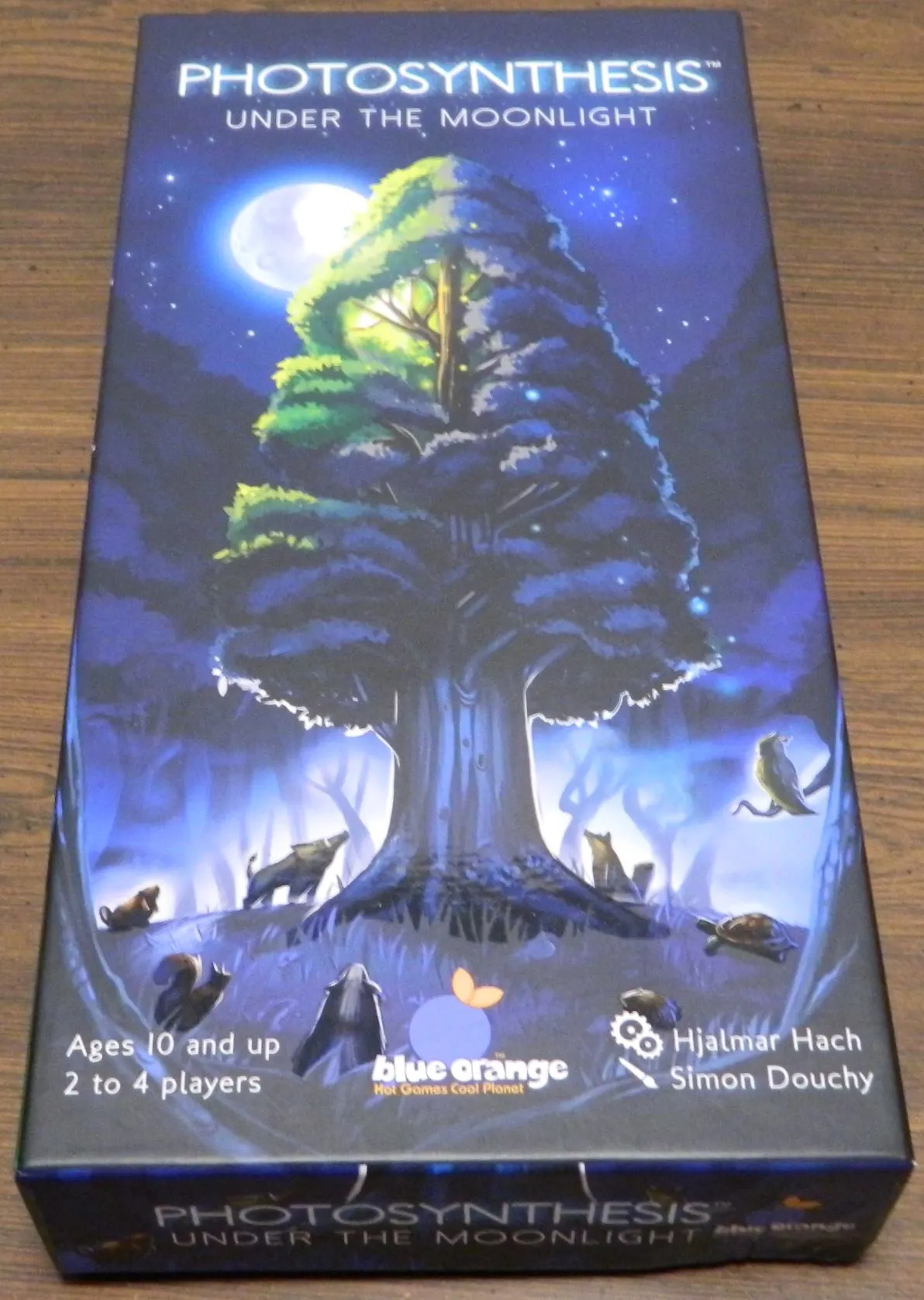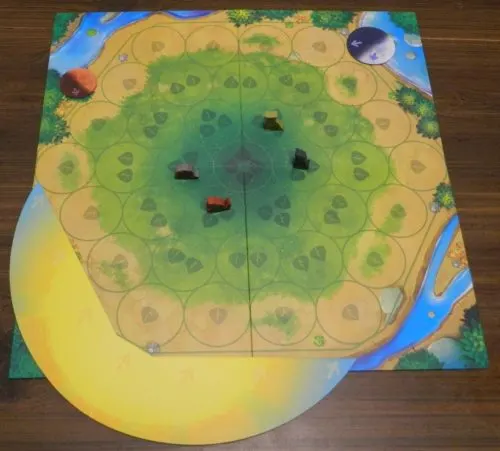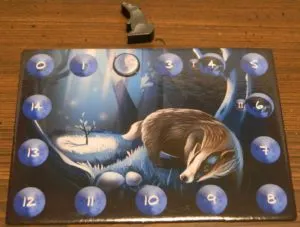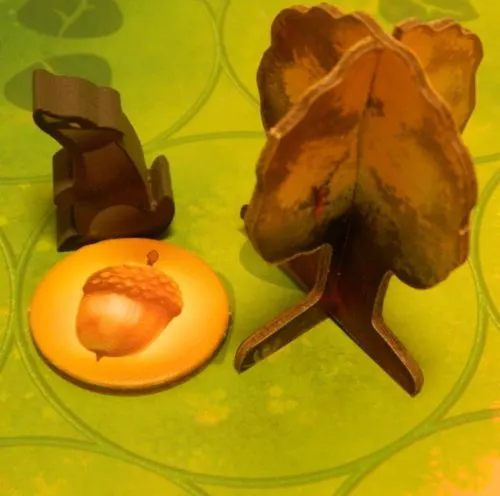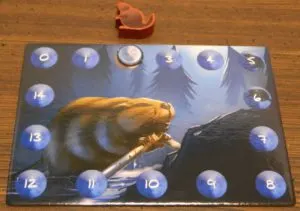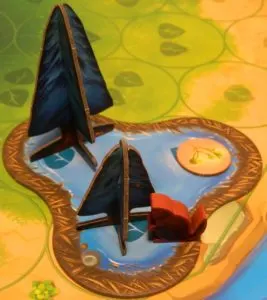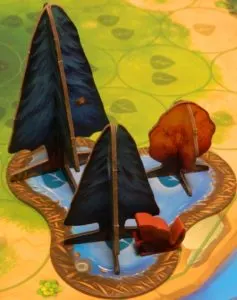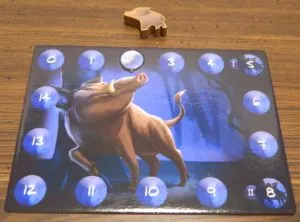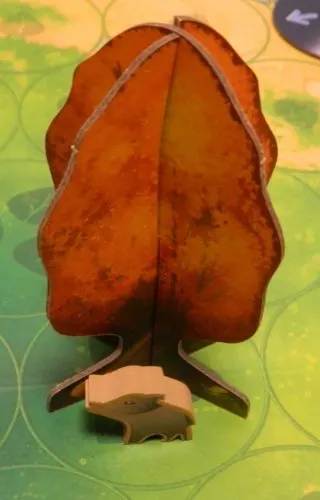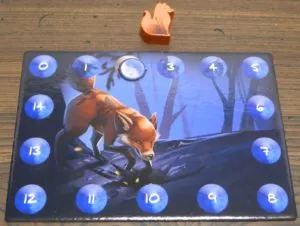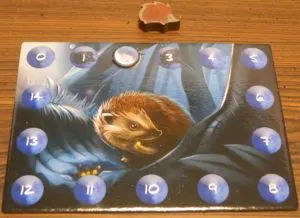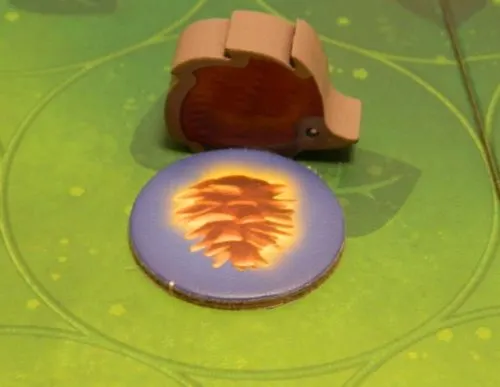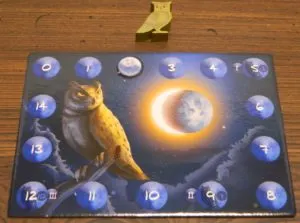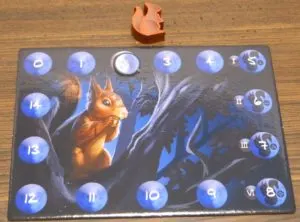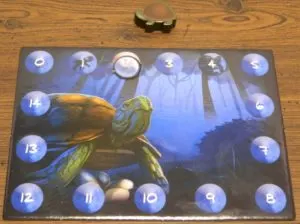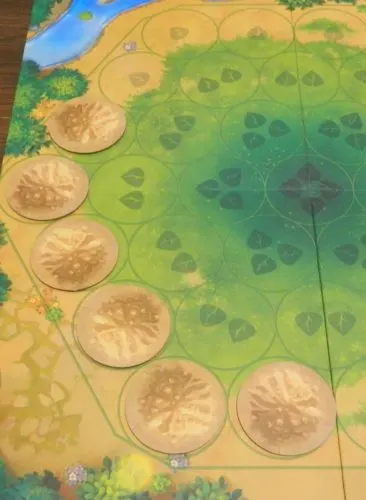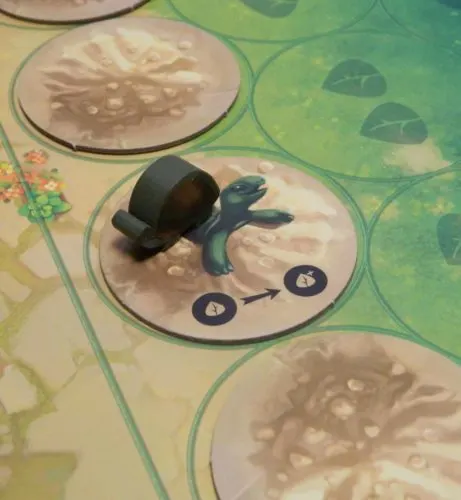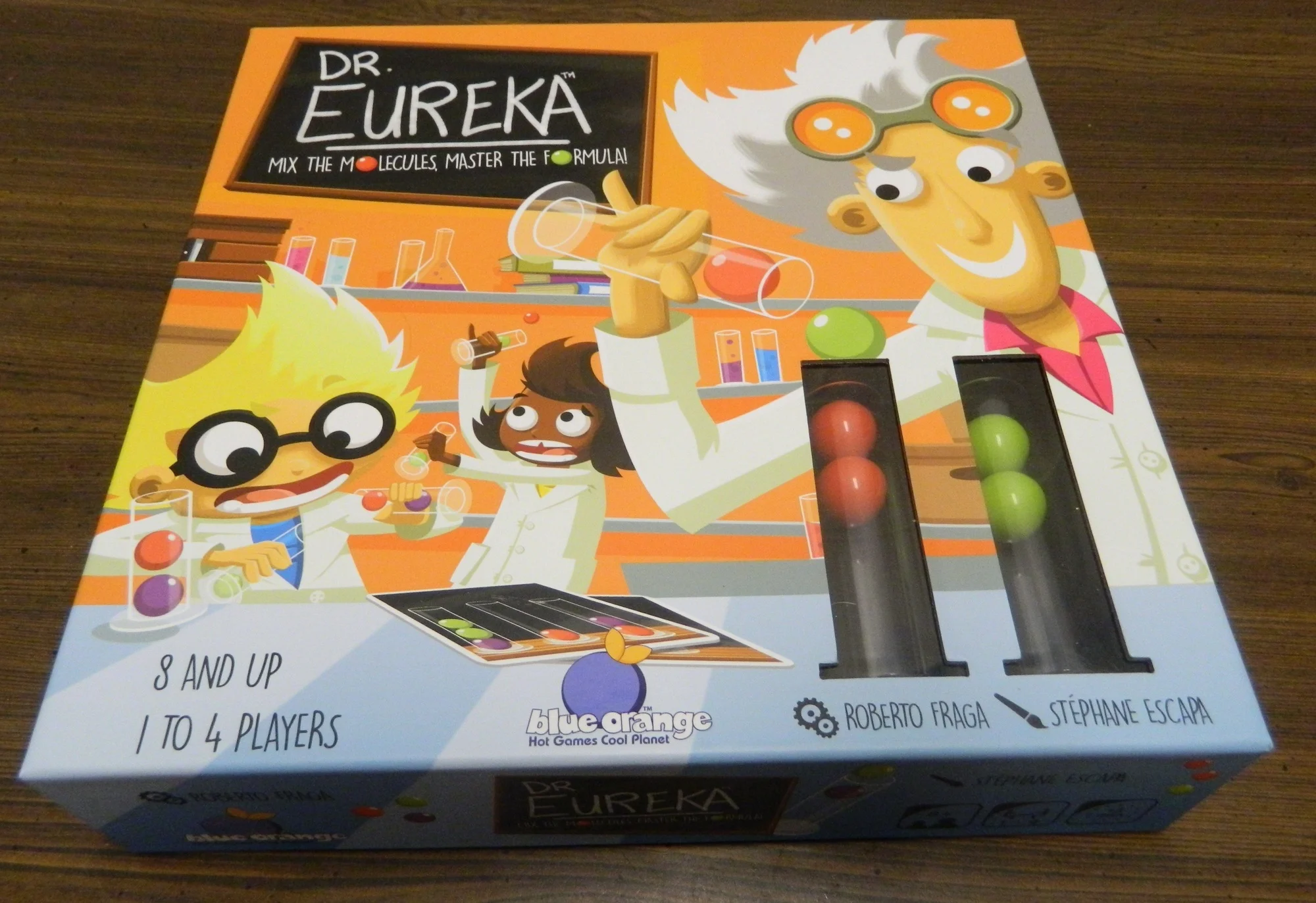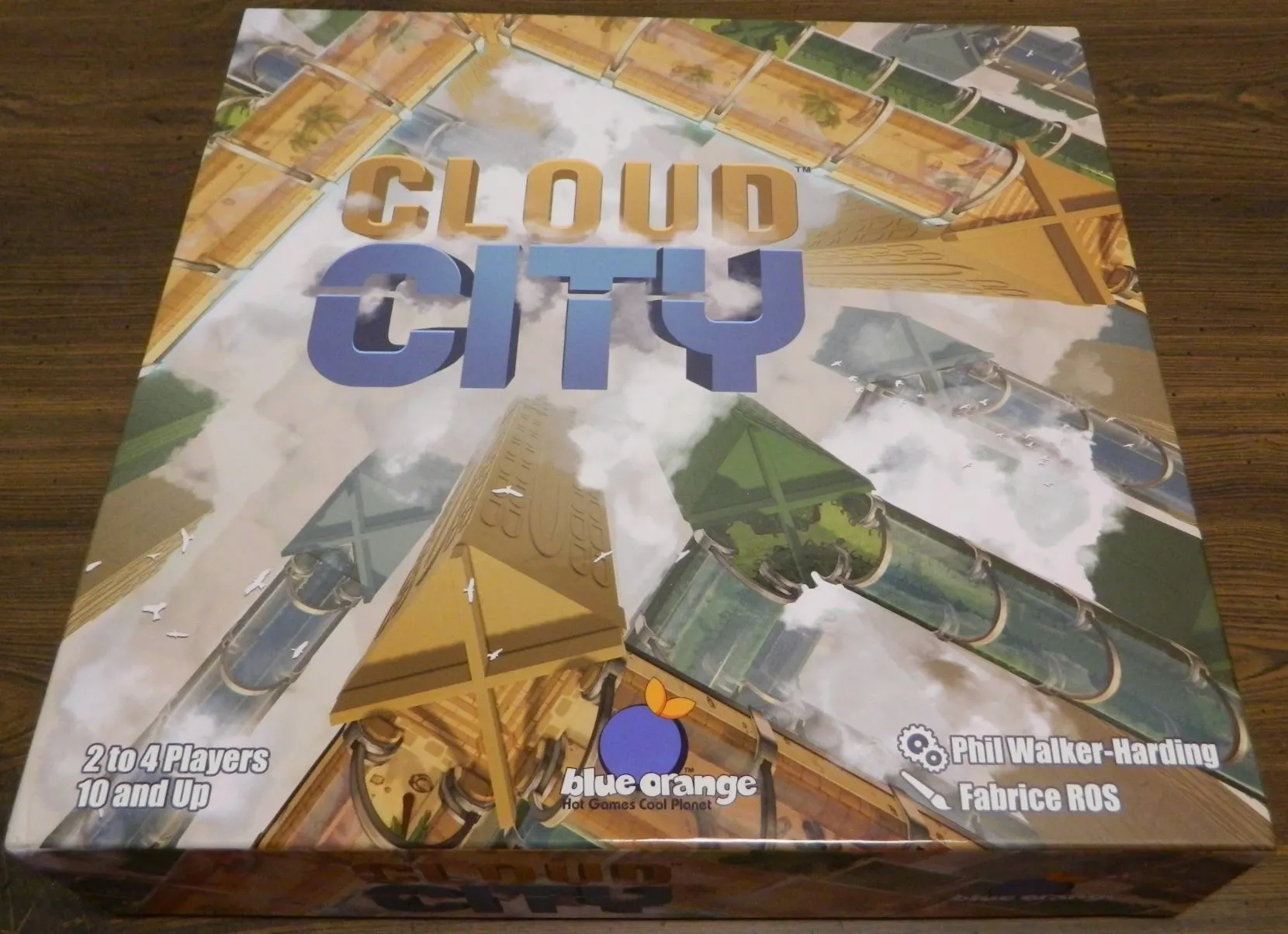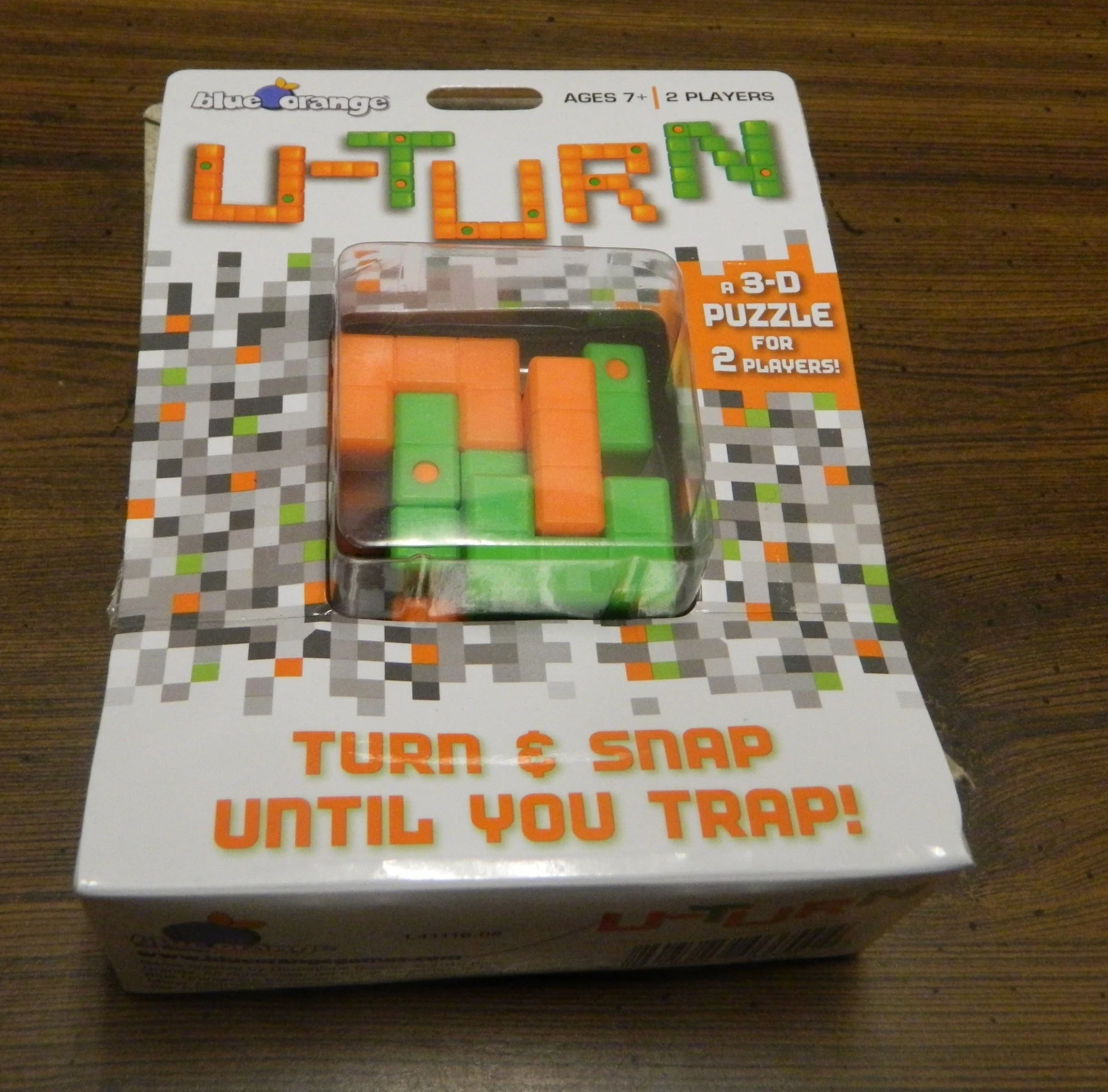Released back in 2017 the original Photosynthesis has become one of the most popular board games of the last couple of years. Three years later Photosynthesis has received its first expansion Photosynthesis: Under the Moonlight which will be officially released next week on October 15th, 2020. I was a little late to Photosynthesis as I only reviewed the original game last week, but I enjoyed it because it was a truly original experience that combined unique mechanics with a theme that fits them perfectly. When Blue Orange Games sent us the expansion to check out I was excited to see what it would add as I thought adding the moon held a lot of potential. Photosynthesis: Under the Moonlight is what you should expect out of an expansion as it adds some interesting new mechanics to the game without interfering with what made the original so enjoyable in the first place.
How to Play Photosynthesis: Under the Moonlight
As Photosynthesis: Under the Moonlight is an expansion to the original Photosynthesis a familiarity with the original game is needed to play the expansion. All of the rules from the original game are applicable to the expansion so check out our review of the original game if you need a reminder of how it is played.
Photosynthesis: Under the Moonlight consists of three modules. When playing with the expansion you can choose to use one, two or all three modules together. For this reason I will be breaking the How to Play section into the rules for each module. If you are playing with multiple modules you will perform the setup for each module in the order that the modules are presented in this section. All setups are also done before the Small Trees are placed in the base game.
The Moon and Forest Animals
Setup
- Place the Moon on the starting point (see the picture below) with the Half-Moon side face up. The Moon Phase tracker will also be placed on its starting point (shown below).
- Shuffle the Forest Animal boards together and deal two randomly to each player. Each player chooses one of the animals to use in the game and discards the other board.
- Each player takes the animal meeple corresponding to their chosen board.
- Each player takes a Lunar Point Tracker and places it on the two space on their Animal board.
- The player to the right of the first player will place their animal meeple on one of the spaces on the Main Board that features three leaves. The players will take turns placing their meeples going counter-clockwise. A meeple cannot be placed on a spot that already features another meeple.
- Based on which animals are chosen additional setup may be needed.
Playing the Game
Photosynthesis Phase
During the Photosynthesis phase the Moon and Moon Phase Tracker will move around the gameboard in a counterclockwise fashion. First the Moon will be moved to the space that the Moon Phase Tracker currently sits on. The Moon Phase Tracker is then moved five spaces counterclockwise around the edge of the board.
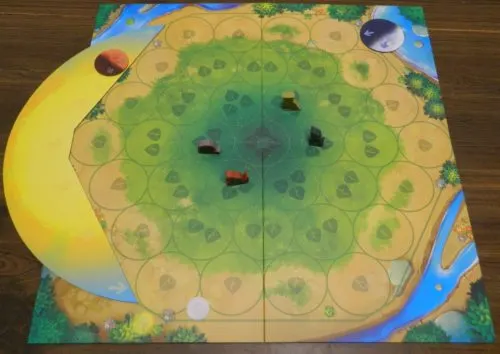
The Moon will be moved to the space where the Moon Phase Tracker is currently located. The Moon Phase Tracker will then move to the space featuring the white chip.
When the Moon Phase Tracker and the Sun cross paths the Moon Phase Tracker will be flipped over. At the beginning of the next round the Moon is flipped over to the same side as the Moon Phase Tracker.
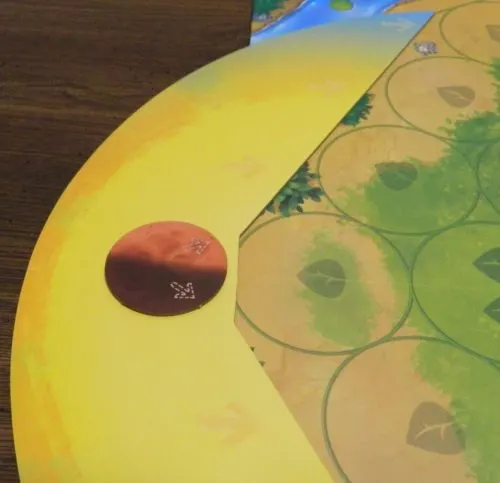
The Moon Phase Tracker has crossed the Sun so it will be flipped over. In the next round the Moon will be flipped over to the other side.
Players will then have the opportunity to collect Lunar Points in addition to Light Points. Looking at the Moon there are two arrows which point to two spaces. Every space in the line that the two arrows point to will receive moonlight. No trees outside of the Great Elder Tree will block the moon. Any animals that are on a space that receives moonlight will earn Lunar Points. If the moon is currently a Half-Moon each animal will receive one Lunar Point. If the Moon is full each animal will receive two Lunar Points.
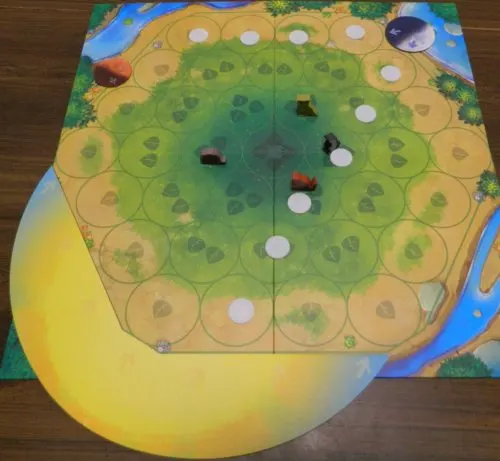
The Moon will shine on the spaces that feature white chips. As it is currently a Half-Moon the Badger and Beaver player will receive one Lunar Point.
If a player’s total of Lunar Points exceed 14 they will lose any additional points that they would otherwise receive.
Life Cycle Phase
During the Life Cycle Phase players have the ability to move their animal and take actions corresponding to their animal.
First each player can move their animal to an adjacent space. An animal can move to a space that contains a Tree or Seed. They may not move an animal to a space that contains another animal, Moonstone, or the Great Elder Tree.
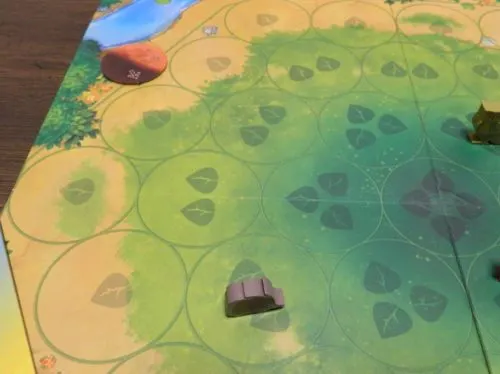
The Hedgehog player has decided to move it to a position that the Moon will shine on in the next round.
The player then has the option to use one or more of the animal’s abilities. To use an ability the player has to pay the corresponding number of Lunar Points. A player can use each ability (an ability with the same name) only once during their turn. Players cannot use multiple levels of the same ability, but they can use abilities that have different names. If an ability contradicts another rule from the game, the ability takes precedence over the other rule. For specifics of each animal ability check out the section below.
Animal Abilities
The Badger
Growing (level 1): 4 Lunar Points – The Badger grows the Seed on its current space to a Small Tree. The Seed must belong to the Badger player. The Small Tree is taken from the player’s Available Area.
Growing (level 2): 6 Lunar Points – This action is the same as level 1 except that the Small Tree can be taken directly from the Player’s Board.
With both of these actions the Seed that the action is used on couldn’t have been planted this turn. Growing a Seed in this way does not count as an action carried out on the space though. Therefore the Small Tree can either plant a Seed or can be grown to a Medium Tree during the turn.
The Beaver
The player who chooses the Beaver will take the Dam tile during setup.
Building the Dam: 6 Lunar Points – The Beaver can take this action if its current space allows it to place the Dam tile next to the river. When placing the Dam tile the leaves pictured on the Dam must match those on the Main Board.
When the Dam is built all Seeds/Trees on the spaces that the Dam covers will automatically grow one size. This includes Seeds/Trees of the other players. In order to take this action though the player must have the next size Tree in their Available Area.
- The player using the Beaver has built the Dam on this space. The blue Medium Tree will grow to a Large Tree, the Blue Small Tree will grow to a Medium Tree, and the orange Seed will grow to a Small Tree.
- This shows the trees having grown after the Dam ability was used.
This action can be taken multiple times during the game, but it must be moved to a position different than its current position.
Improving the Dam: 5 Lunar Points – If the Beaver is on one of the three spaces of the Dam they can take this action. By taking this action they can grow one of their Seeds/Trees one size. The next Tree must be in their Available Area though.
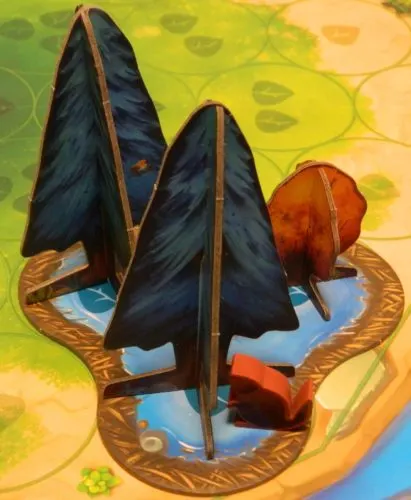
The Beaver player used the Improving the Dam ability to grow the blue Medium Tree into a blue Large Tree.
The Boar
Digging (Level 1): 5 Lunar Points – When a player takes this action they can Collect the Large Tree that is on their current space. By taking this action the player doesn’t need to spend Light Points. The player can only Collect one of their Large Trees.
Digging (Level 2): 8 Lunar Points – In addition to the abilities of level 1 the player can also immediately plant one of the Seeds from their Available Area on the space that they took the Tree from. This Seed cannot be grown during the rest of the player’s turn.
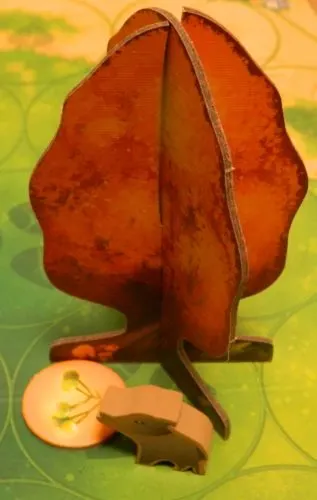
The player has decided to use the second level of the Boar’s Digging ability to Collect the Tree and replace it with a Seed.
The Fox
Scaring: 1 Lunar Point – The player can move another animal in a space adjacent to the Fox one space.
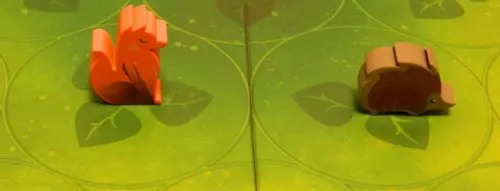
The player controlling the Fox has decided to use the Scarring ability on the Hedgehog on the adjacent space. They will be able to move the Hedgehog to an adjacent space.
Scratching the Soil: 3 Lunar Points – The Fox moves a Seed from its current space to another space one or two spots away (this must be in a straight line). This Seed can belong to the Fox player or another player. This action does not count as an action performed on either of the two spaces. If a Seed is moved that was just planted it cannot be grown on the same turn.
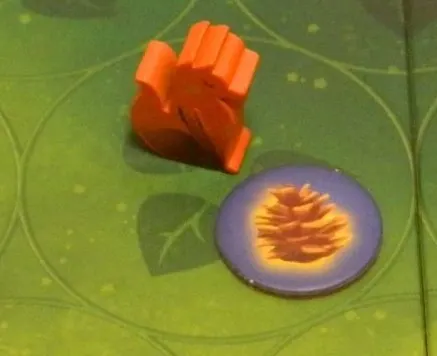
The Fox player can use the Scratching the Soil ability to move this Seed to a space one or two spaces away.
Stealing: 4 Lunar Points – The Fox player can steal two Light Points from a player whose animal is on an adjacent space to the Fox.
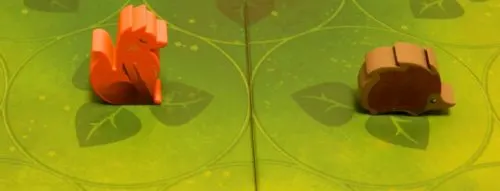
If the Fox player uses its Stealing ability they can take two Light Points from the Hedgehog player.
The Hedgehog
Running: 1 Lunar Point – When the Hedgehog runs it can move an additional space.
Planting: 3 Lunar Points – If the Hedgehog is on an empty space they can take a Seed from their player board and place it on the Hedgehog’s current space.
The Owl
Nighttime Hunting (level 1): 5 Lunar Points – You will receive 3 Light Points.
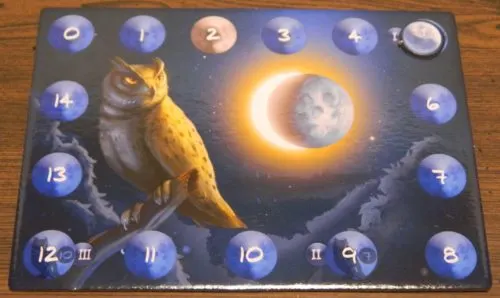
This player chose to use the Owl’s Nighttime Hunting ability to turn five Lunar Points into three Light Points.
Nighttime Hunting (level 2): 9 Lunar Points – You will receive 7 Light Points.
Nighttime Hunting (level 3): 12 Lunar Points – You will receive 10 Light Points.
The Squirrel
The Squirrel has a passive ability that doesn’t cost any Lunar Points. The Squirrel can move either one or two spaces during a player’s turn. While moving two spaces the Squirrel is able to change directions.
The Squirrel’s active ability allows it to eat other player’s Seeds that are on the Main Board. If the Squirrel is on a space with another player’s Seed they can use the ability to eat the Seed and return it to the Player’s Board on the lowest remaining space. The owner of the Seed will receive one Light Point as compensation for losing their Seed. The player controlling the Squirrel will receive 1 Light Point for each leaf on the space that the Seed was eaten from.
Eating (level 1): 5 Lunar Points – The Squirrel can eat a Seed from a space with one leaf.
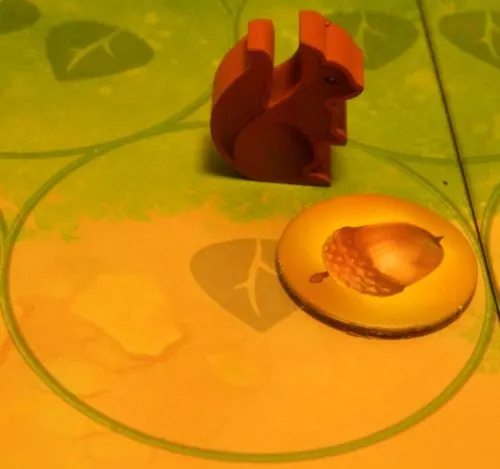
This player has decided to use the Squirrel’s Eating ability. As the Seed was on a one leaf space the player whose Seed was eaten will receive one Light Point and the Squirrel player will also receive one Light Point.
Eating (level 2): 6 Lunar Points – The Squirrel can eat a Seed from a space with two leaves.
Eating (level 3): 7 Lunar Points – The Squirrel can eat a Seed from a space with three leaves.
Eating (level 4): 8 Lunar Points – The Squirrel can eat a Seed from a space with four leaves.
The Turtle
During setup the Turtle player will take some additional actions.
- Shuffle the 8 Baby Turtle Tokens face down.
- Randomly take 6 of the tokens and place them on the beach spaces on the Main Board.
- The remaining tokens are returned to the box.
Hatching A Baby: 4 Lunar Points – When the Turtle is on one of the face down Baby Turtle tokens they will flip it over and place it in their Available Area.
Baby Turtle’s First Steps: 1 Lunar Point – The Turtle player can use this ability to activate the ability of one of the Baby Turtle Tokens in their available area. These abilities can be activated at any time no matter the position of the Turtle. Once a Baby Turtle Token has been used it is returned to the box. You cannot take this action multiple times on your turn. The special abilities of the tokens depend on which is activated:
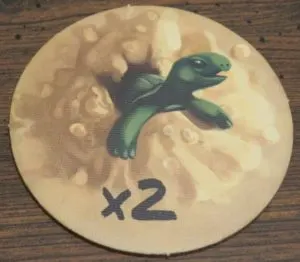 The player can perform two actions on the same space in a turn.
The player can perform two actions on the same space in a turn.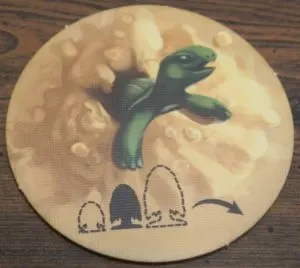 The player can take one Medium Tree from their Player Board and add it to their Available Area for free.
The player can take one Medium Tree from their Player Board and add it to their Available Area for free.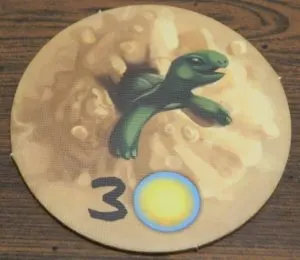 They will receive three Light Points.
They will receive three Light Points.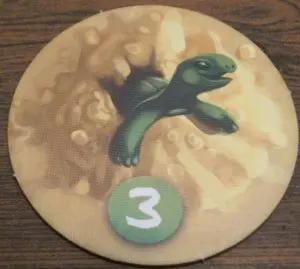 They will receive three victory points. They will place this token on the Turtle board and it will score three points at the end of the game.
They will receive three victory points. They will place this token on the Turtle board and it will score three points at the end of the game.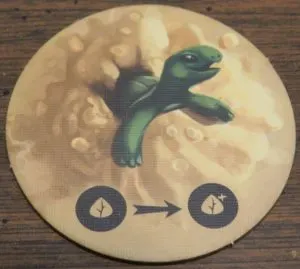 When a player Collects a tree they will take a Scoring Token that features one additional leaf.
When a player Collects a tree they will take a Scoring Token that features one additional leaf.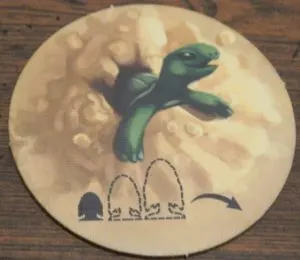 The player will take one Small Tree from their Player Board for free and add it to their Available Area.
The player will take one Small Tree from their Player Board for free and add it to their Available Area.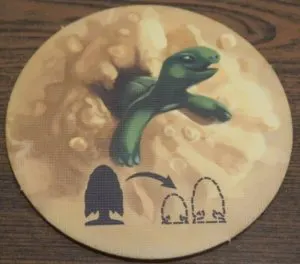 The player will Collect one of their Large Trees for free.
The player will Collect one of their Large Trees for free.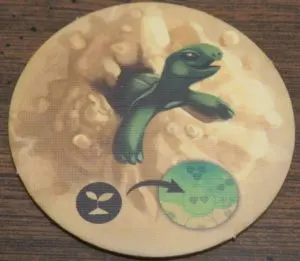 The player can plant one of the Seeds from their Available Area on any empty space on the Main Board for free.
The player can plant one of the Seeds from their Available Area on any empty space on the Main Board for free.
Great Elder Tree
Setup
The setup for this module will take place before players place their Small Trees on the Main Board. The last player in turn order will get to place The Great Elder Tree on an empty space on the Main Board of their choice. If a player is playing with the Turtle, the Great Elder Tree cannot be placed on a space that has a Baby Turtle Token.
Playing the Game
The Great Elder Tree does not belong to any of the players and thus cannot be Collected. The Great Elder Tree casts a shadow on all spaces on the opposite side of the Sun and Moon. Any animals or Trees positioned behind the tree will not receive any Light or Lunar Points. No Seeds can be placed on the spot and no animals can move to the space.
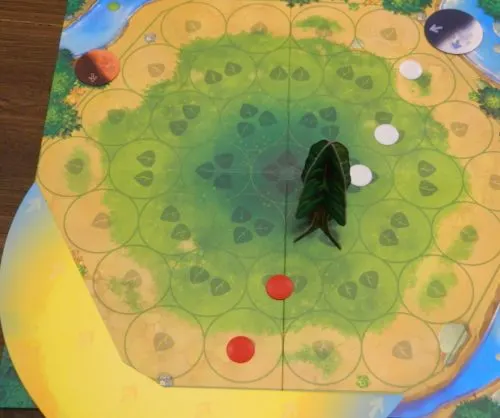
The Great Elder Tree’s sun shadow will cover the spaces featuring white chips. The Great Elder Tree will block the moonlight from the Moon on the two spaces featuring red chips.
Moonstones
Setup
This setup will take place before players place their Small Trees on the Main Board.
The number of Moonstones that you will use in the game depends on the number of players:
- 2 players – 3 Moonstones
- 3 players – 2 Moonstones
- 4 players – 0 Moonstones unless playing with the Great Elder Tree where you will use 1 Moonstone.
Players will then place the Moonstones on the Main Board as follows:
- If the Great Elder Tree is being used the player to the right of the player who placed the Great Elder will get to place the first Moonstone. The Moonstone can be placed on any empty space. This continues counterclockwise until they have all been placed.
- If the Great Elder Tree is not being used the last player in turn order will place the first Moonstone and the rest will be placed by the next player(s) counterclockwise.
If one of the players are playing with the Turtle, Moonstones cannot be placed on a space with a Baby Turtle Token.
Playing the Game
Moonstones do not belong to any of the players and they cannot be removed or moved during the game.
The Moonstones cast a shadow for the Sun similar to a Small Tree.
If the moonlight hits a Moonstone it will start shining moonlight onto all of the adjacent spaces. During the Photosynthesis Phase any animals on one of the adjacent spaces to a shining Moonstone will receive the corresponding amount of Lunar Points even if the Moon doesn’t directly shine on the animals. If a Moonstone directs moonlight to another Moonstone that stone will also illuminate its nearby spaces.
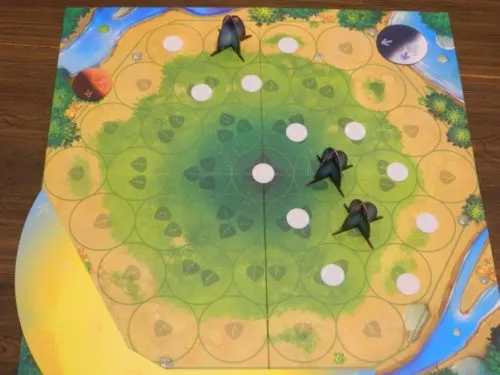
The Moonstone in the top row is hit by the moon so it would radiate moonlight to the adjacent spaces. The Moonstone in the middle row would be hit by the moonlight which will radiate to the neighboring spaces. This would also activate the other Moonstone which will spread the moonlight to its adjacent spaces. The white chips show the spaces that the moonlight will be radiated to based on the Moonstones.
No Seeds may be placed on a space that features a Moonstone. Animals cannot be moved to a space that contains a Moonstone.
End of Game
The scoring at the end of the game is the same as the base game.
Players will also receive one Scoring Point for each Lunar Point not used.
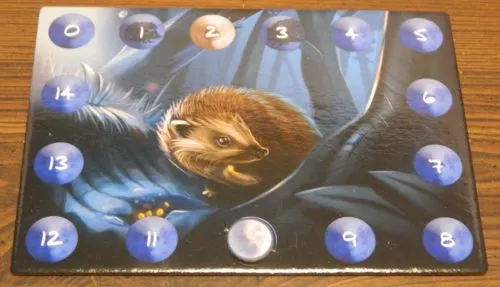
This player has ten Lunar Points left at the end of the game. These will convert to ten Scoring Points at the end of the game.
If a player is using the Turtle and they activated the Baby Turtle Token that gives them three points, they will add those points to their total.
My Thoughts on Photosynthesis: Under the Moonlight
In a lot of ways Photosynthesis: Under the Moonlight is basically what you would expect from an expansion. All of the rules from the original game are still applicable as the expansion doesn’t really touch on any of these mechanics. Instead the expansion adds a few other mechanics to the game. As I have already reviewed the base game I am going to stick to what the expansion adds to the experience in this review. I would say that the expansion includes three modules with one being a major module and the other two being minor modules. For this reason I am going to break my analysis down into the individual modules.
I am going to begin by talking about the Moon and Forest Animals module as it is by far the biggest addition added in Photosynthesis: Under the Moonlight. This module adds two main mechanics to the game: the moon and animals.
The name of the expansion should have been a dead giveaway, but the expansion focuses heavily on the moon. In the base game one of the keys was to track the sun and make plays that would help you receive more sunlight on future turns. The expansion has a similar mechanic where instead of the sun you are trying to track the movement of the moon. The moon moves in the opposite direction of the sun, but instead of moving from side to side it moves a number of spaces. Unlike the sun the moon only shines in two lines indicated by the arrows on it. The moon also ignores shadows outside of the Great Elder Tree. During the Photosynthesis Phase players can receive lunar points if they can move their animal into the path of the moon. These lunar points can then be used to perform the animal’s abilities which can have a number of impacts on the game.
I will get into lunar points shortly but I first wanted to talk about the moon itself. Adding the moon to the game does add a little complexity to the game it is is another thing that you have to handle during the Photosynthesis Phase. The process of moving the moon is pretty simple, but it will take a few rounds for you to fully grasp it. Like tracking the sun, being able to track the moon well is key to the expansion. During each Life Cycle Phase you need to analyze the current position of your animal to determine if there is a way to move to a space that puts them in the path of the moon for the next round. You also need to analyze future positions so you can make sure that the animal is in a good position to continue receiving lunar points. This is a key part of the game since the more lunar points that you collect the more you can utilize the other new mechanics.
Receiving lunar points is important because they allow you to use your animal’s special abilities. These abilities are arguably the largest mechanic that the expansion brings to the game. Each player is given an animal at the beginning of the game which gives them special abilities that they can implement in the game. Many of these special abilities play off of mechanics from the original game as you can use lunar points instead of light points to perform a given action. Others allow you to mess with the other players. Then there is the turtle and beaver that add new mechanics to the game.
I thought the additions of these abilities were pretty interesting. A lot of the abilities have very specific times where they will be useful. All of the abilities seem to have periods where they can play a crucial role in the game though. You may only use an ability a couple of times during the game, but those uses may have a huge impact by creating a turning point in the game. Some of these abilities allow you to interact with the other players as well and really mess up their strategy.
I haven’t played with the animals enough to tell if some are more powerful than others, but I am guessing most players will have their own favorites as each has strategies that they will work best with. Some of the animals are better with less players while others have more use with four players. I will say that the two animals that seem to change up the gameplay the most are the beaver and the turtle as their abilities are the most unique. Since players will likely have their own personal favorites I would honestly think about waiving the rule where players randomly draw animals if all of the players want different animals. With players randomly drawing animals you may get stuck with one that doesn’t work with what you are otherwise trying to do.
I have to say that adding this module to the game does add some complexity to the game. This is due to having to move the moon, determining if you receive lunar points, and using the various animal abilities. The most difficult part about this is just remembering the other mechanics that you have to deal with. In particular it takes some time to familiarize yourself with all of the animal abilities. None of these mechanics are that hard to understand, but they do take some time. For this reason I wouldn’t recommend playing the expansion with players that aren’t familiar with the base game.
I thought this was a nice addition to the game, but I do have one problem with the whole moon mechanic. This comes from the fact that I think the lunar points are too powerful at the end of the game. Whatever lunar points you don’t use will then convert to victory points. I like that the lunar points translate to victory points. I think the exchange rate should have been lower though. There are cases where it is definitely worth using the lunar points for an ability. In many cases though you are probably better off just saving your points and cashing them in at the end of the game. The game occasionally forces you to use lunar points as you can only store 14 of them. If you refrain from using your abilities though you will receive a lot of points at the end of the game which will be hard to overcome. I think the lunar points should have had an exchange rate of a least two lunar points for one victory point as this would have encouraged players to spend more of their points. I will admit that this could all be due to the players that I played with including myself being the type of players that tend to hoard resources rather than spend them.
Now that I have discussed Photosynthesis: Under the Moonlight’s main module lets move onto the minor modules. I want to first talk about the Moonstones as they are mostly connected to the main module. In fact I don’t really see the point of using them if you aren’t using the main module because they otherwise just act as obstacles on the board that get in the way. Basically the Moonstones act as a beacon which makes it considerably easier to receive moonlight with your animal. When a Moonstone is hit by the moon it will radiate it to all of the adjacent spaces.
I would say that the Moonstones are more of a complimentary module, but I thought they were a pretty good addition when used with main module. Whether you use the Moonstones really depends on how much emphasis you want to put on the moon in the game since they make it much easier to receive lunar points on your turn. The Moonstones make it much easier to get your animal into position to receive lunar points when you otherwise wouldn’t be able to. This gives you a lot more lunar points to spend in the game which means the animal powers can be used more and players will receive more points at the end of the game from their remaining lunar points. I plan on using the Moonstones in most of the games where I also use the moon as I like receiving a lot of lunar points. I would maybe cut down on the number of Moonstones in the two player game though as three appears to be too many. Those that want to make lunar points more scarce though may not want to use the Moonstones.
The last module is The Great Elder Tree. Of the three modules the Great Elder Tree seems to be more of its own thing. Basically it acts as an obstacle in the game. It blocks one of the spaces on the board for the entire game and casts a shadow for both the sun and moon on every space behind it. The Great Elder Tree can have a significant impact on the game. Players either need to avoid placing trees in its path or be willing to accept not receiving as much light points during a turn than they otherwise could have. This adds another interesting decision that players have to keep in mind before they place trees.
I personally don’t have strong opinions of The Great Elder Tree in either direction. I will probably end up using it in some games and not in others. I think a lot of it comes down to the player count. In my opinion it probably works better with less players. With only two players you can somewhat work around it as there are enough spaces to place trees where you can choose to avoid it. With four players though I fear that the board is going to be crowded as many of the spaces will be filled in where the Great Elder Tree is going to have a pretty big impact on some of the players. Ultimately I found it to be a decent addition to the game, but I wouldn’t consider it a major selling point for the expansion.
Before wrapping up I wanted to quickly talk about Photosynthesis: Under the Moonlight’s components. In the review of the base game I commented on the components as being really good. The same holds true for the expansion. I have to begin with the animal meeples. They are arguably the cutest meeples that I have ever seen in a board game. The meeples look custom where each has a different shape. They even have artwork on two of their sides which makes them really stand out. Otherwise the game comes with quite a few cardboard pieces. These pieces are comparable to the base game as they are made of pretty thick cardboard and the artwork is really good. I really only had two complaints with the components. First I wish the Great Elder Tree was a little taller so it would stand out a little better among the other trees. Otherwise I wish the game would have come with reference cards for the various animals. Until you have played with them enough to remember their abilities you will have to keep referencing the rules to remember what each one can do. The game does a good job using symbols on the boards to indicate the abilities costs, but you have to remember what each of the actions do. Reference cards would have helped as there could have been one for each animal which would have been much easier to reference. In all Photosynthesis: Under the Moonlight deserves credit for its components like the base game.
Should You Buy Photosynthesis: Under the Moonlight?
In many ways Photosynthesis: Under the Moonlight is what you would expect from an expansion. It doesn’t drastically alter the original gameplay, but instead adds to it. The expansion is basically broken down into three modules. The first adds the moon and animals to the game. Basically the moon acts similar to the sun where you can collect lunar points from your animals. The animals can then use those lunar points to take special actions in the game. These abilities can play a pretty big role in the game if used at the right time. I generally liked this mechanic as it adds some interesting elements to the game. I do think your remaining lunar points at the end of the game are too powerful though. The next mechanic is the Moonstones which mostly make it easier to receive lunar points. I liked this even though others may prefer to not use them if they want the moon to play a lesser role in the game. Finally the Great Elder Tree is mostly used as an obstacle that blocks the sun. Of the three modules I liked this the least as I will only use it from time to time. Finally like the base game Photosynthesis: Under the Moonlight’s components are also great.
My recommendation for Photosynthesis: Under the Moonlight comes down to your thoughts on the original game and whether you think the addition of the moon, animals and their special abilities sound like something that you would enjoy. If you enjoy the original game and are looking for something that mixes things up I think you will enjoy Photosynthesis: Under the Moonlight and should consider picking it up.
Buy Photosynthesis: Under the Moonlight online: Blue Orange Games
Photosynthesis: Under the Moonlight will be released on October 15th, 2020.
We would like to thank Blue Orange Games for the review copy of Photosynthesis: Under the Moonlight used for this review. Other than receiving the review copy we at Geeky Hobbies received no other compensation. Receiving the review copy had no impact on the content of this review or the final score.

